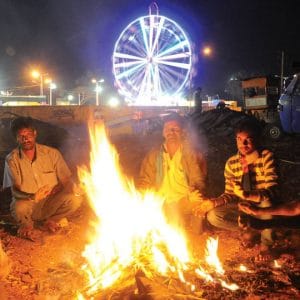It is a practice mostly seen in South Indian Vishnu temples. After the devotee pays obeisance to the deity (darshan), the priest places a crown on his head. But it is not quite a crown. On top are the footprints of the deity. Since the devotee cannot enter the sanctum sanctorum, which is kept ritually isolated, and touch the feet of the icon within, the deity’s feet are symbolically placed on the devotee’s head. Rituals such as these reveal a lot about Hindu bhakti traditions, which are often linked to India’s feudal traditions, but have a deeper connection with the country’s monastic heritage.
Bhakti originally did not mean submission. It meant participation in the life of the divine. People had long been ‘upasakas’ or worshippers of trees, animals, rocks and saints, as well as ‘shravaka’ or followers of hermits and gurus. This new idea was different. Temples were not serene centres of meditation — where people went to renounce the world. They were different from Vedic yagna-shalas, restricted to priests and their royal patrons. These were centres to celebrate life itself.
Temples or devalayas were the residences of divine beings who occupied stone and metal icons, who had to be bathed every day, dressed, fed, entertained and during festivals taken on joy rides on chariots and boats.
There were ceremonies to celebrate their marriages and victories on the battlefield and other stories of their lives, and people were invited and encouraged to participate in them. This was the original bhakti movement.
To fund these activities, village grants were given to the deities. This was known as deva bhoga. The managers of these lands were the educated Brahmins, appointed as stewards by the king and excess resources were used to build temples. Therefore, by the 8th and 9th centuries, across India, we saw temples being built simultaneously. The shrines perhaps existed even before, but they came under royal and priestly, supervision at this time.
Thriving on inequality
Temple lore invariably includes stories of devotees not permitted to enter temples because they belong to ‘impure’ professions. Forced to stay outside, they compose fabulous poetry, which makes them very popular. Such stories reveal a dark side that coexists with the rise of the temple movement. The stratification of society on the basis of purity.
For example, we hear the story of Thirupan Alwar in Srirangam, a great singer, who is not allowed to use certain parts of the Kaveri river where the Brahmins go to bathe, which are considered to be sacred. In fact, one Brahman throws a rock at the singing saint who accidentally comes to the sacred portion of the river. The deity is so upset by this incident that, in his dreams, the Brahmin sees the deity bleeding from the head. They demand that the saint be brought into the temple. Having seen the deity for the first time inside the temple, Thirupan Alwar describes him beautifully from foot to head.
In Vishnu art, the goddess of fortune, Lakshmi, is always shown at the foot of the divine. He embodies contentment; she embodies fortune. This was a graphical representation to show how fortune serves the content. Modern readers, though, may argue this indicates the inferior position of women, since we are conditioned to see the body in hierarchical terms: the head is greater than the feet; the right side is more sacred than the left; the upper body is purer than the lower. It is almost as if we thrive on inequality and want to deny respect to even our own bodies.
Look down for fortune
To reject the foot is then to reject fortune. To venerate the foot is to venerate fortune. Those who bow their head, receive the footprint of the deity and with it fortune. The head is the mind — the fountain-head of gluttony as well as contentment. The glutton chases Lakshmi. Lakshmi chases contentment. This is the central theme of Vishnu lore. Contentment does not feel the need for hierarchies and boundaries — to keep people out of temples, to deem them impure.
A severed demonic head is placed atop many a South Indian temple, devoid of limbs, a reminder of arrogance and gluttony. The head needs to be completed by the body. The body is upheld by the feet. Our tendency to hold our head high, without looking at those at our feet, is the cause of our fall. In gluttony, we consume everything, even our feet and our body. All these ideas emerge when one observes the ritual of the crown with the deity’s footprint.
Dr. Devdutt Pattanaik – Author, Speaker, Illustrator, Mythologist








Recent Comments